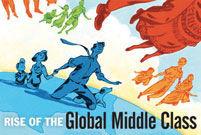 |
Christian Science Monitor...
Surging BRIC middle
classes are eclipsing global poverty
By Christa Case Bryant
May 17, 2011
By 2022, those living in poverty will be a minority for the first time,
as the global middle class – particularly from BRIC nations – surges.
Does new affluence signal shifting global power?
Illustration by Tim Bower
Touting tigers, the Taj Mahal, and the towering Himalayas, India opened
the 21st century with its “Incredible India” campaign to attract
tourists from around the world. But the unexpected happened. A
surprising new face showed up on the Indian tourism scene to fill hotel
rooms and tour bus seats: Indians themselves.
They were people like Ash Narian Roy, who grew up in a rural hut but
today has a PhD and works in Delhi. They are the new Indian middle
class, who have begun exploring new horizons of education, culture, and
leisure.
“Ten years ago,” muses Dr. Roy, whose increasing ability to travel
parallels the past decade’s explosive growth of the middle class, “we
may have gone near Shimla in our own car.” But now he hires a driver to
take his family into the heart of that cool summer resort in the
Himalayas. And he even jets off to the beaches of Goa in the south.
The curious and free-spending domestic traveler like Roy, says Amitabh
Kant, an Indian development official who wrote the book “Branding
India: An Incredible Story,” is an “economic savior” for India. And, to
boot, Mr. Kant says, middle-class Indians are a powerful market abroad,
now outspending Americans in London, for example, by 10 percent.
The “Incredible India” surprise is part of a surge of prosperity that
is rapidly expanding the world’s middle classes. By 2030, the global
middle class is widely projected to at least double in size to as many
as 5 billion – a surge unseen since the Industrial Revolution. This
boom, however, is more global, more rapid, and is likely to have a far
different – and perhaps far greater – impact in terms of global power,
economics, and environment, say economists and sociologists.
“This dwarfs even the 19th-century middle class explosion in its global
scale,” noted economists Dominic Wilson and Raluca Dragusanu in a 2009
Goldman Sachs report. And they predicted, “the pace of expansion ... is
likely to pick up.”
The world will, for the first time in history, move from being mostly
poor to mostly middle-class by 2022, the Organization for Economic
Cooperation and Development projects. Asians, by some predictions,
could constitute as much as two-thirds of the global middle class,
shifting the balance of economic power from West to East. Already, some
analyses of International Monetary Fund data suggest that the size of
the Chinese economy could eclipse that of the United States in just
five years.
In just one example of the rising clout of this new global middle
class, in a mere seven years China has gone from buying 1 General
Motors car for every 10 sold in the US to becoming the American
automaker’s biggest customer – not to mention becoming a big competitor
at the gas pumps.
But today’s middle-class boom is unlike the Industrial Revolution, in
which rising prosperity became a catalyst for increased individual and
political freedom. Those in the emerging global middle classes – from
an Indian acquiring a flush toilet at home to a Brazilian who can now
afford private school to a Chinese lawyer with a new car in the
driveway – are likely to redefine their traditional roles, and in doing
so, redefine the world itself.
“I would expect that as the global middle class gets transformed by the
entrance of hundreds of millions of Indian, Brazilian, and Chinese
families, the concept of what we see as the middle-class values may
change,” says Sonalde Desai, a sociologist with the National Council of
Applied Economic Research in Delhi (NCAER). “Historically, sociologists
have defined ‘middle class’ as those with salaries…. I think ‘middle
class’ is very much a state of mind.”
Who are they?
From Aristotle to Alexis de Tocqueville, Western thinkers have
championed the middle class as essential for prosperous, enlightened
societies. They held it up as the engine for economic growth, the
guardian of social values, and an impelling and protecting force for
democracy.
The new members of the middle class have been praised for their work
ethic, like the shopkeepers, tradesmen, and professionals who spurred
the Industrial Revolution.
But they also differ in fundamental ways. They come from communal
societies that rein in the individualism prized in 1800s America. Their
exposure to the pitfalls of the West’s extravagant consumerism often
makes them more frugal and environmentally conscious. And they are
hesitant – for now, at least – to risk prosperity for political freedom.
“China’s rapid growth has been a kind of anesthetic that keeps
political discontent manageable,” says Brink Lindsey, whose book “The
Age of Abundance” links America’s post-World War II prosperity and its
mind-opening educational opportunities to the social and political
upheaval of the 1960s and ‘70s. “But already [in China] things are
dramatically different. People have much more freedom in their lives.”
That’s a sneak preview, he says, of what lies ahead for developing
countries – particularly the awakening giants of the middle class:
Brazil, Russia, India, China, and South Africa, the so-called BRICS
economies.
Read the full story at Christian Science Monitor
|

